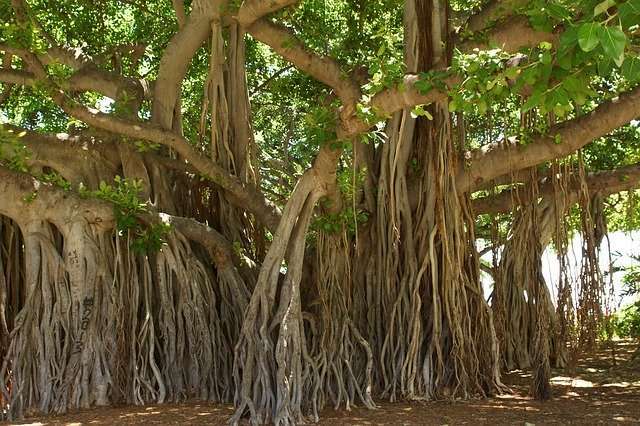 |
| What is Banyan tree - Where is the world's largest Banyan tree |
Banyan Tree
Where is the world's largest Banyan tree? Banyan is a large multi-year tree. This tree is also called 'Vat' and 'Bad'. It is a terrestrial dicotyledonous and flowering tree. The stem of the banyan is straight and hard. Banyan branches get stuck in the air and hang in the air and enter the growing earth and become pillars.
These roots are called Baroh or Prap root. The banyan fruit is small, circular and red in colour. The seed is also found in it. The banyan seed is very small, but its tree is very large. Banyan leaf is broad and almost elliptical. Breaking of its leaves, branches and buds produces milk-like juice called latex acid.
Religious significance
The banyan tree is very important in Hinduism. Banyan (vat), like the trinity of Brahma, Vishnu and Mahesh, is considered. It is believed that by worshipping the banyan and giving water to its root, one attains virtue. The banyan (vat), the tree symbolizes the trinity. Is believed to be Vishnu in the bark of the banyan, Brahma in the banyan root and Shiva in the banyan branches.
Just as the Peepal is considered a symbol of Vishnu, so the banyan is considered as Shiva. Vatavriksha is also worshipped in many fasts and festivals.
The intended people of children do special worship of it. Banyan symbolizes the creation of nature, Banyan lives for a long time, it is also called "Akshayavat".
Scientific significance
The scientific and unique importance of the Banyan tree.
- Banyan shadow directly affects the mind and keeps the mind calm.
- Banyan tree remains green even in times of famine. So at this time, it is easy to feed animals on its leaves and people on its fruits.
- The milk produced from the branches and leaves of the banyan tree has a tantric use.
- Medicines are also made from the bark and leaves of the banyan.
Where is the world's largest banyan tree
The Great Vest Tree
Like millions of banyan trees are still left in the world. Millions of banyan trees are still left among them, in many thousands of old banyans. Ujjain's provenance in India, Prayag's Akshyavat, Mathura-Vrindavan's Vanshivat, Gaya's Gavant, Panchavati ( Nashik) is considered to be the main five. But apart from this, there are many giant Vat trees found in India. One of them is 'The Great Vest Tree'.
On seeing this giant tree for the first time. It is understandable that it is a small forest in which thousands of similar trees are grown. But after looking closely, it is understandable that it is a single tree. Whose roots and stems have spread all around.
India has the world's largest banyan tree
You will be surprised to know that the world's largest banyan tree is in India. Thousands of tourists from every country and abroad come to see this banyan.
This banyan tree is in Acharya Jagdish Chandra Bose Botanical Garden, Kolkata. When the Botanical Garden was established in the year 1787, the age of this banyan was from 15 to 20 years. In this context, the age of this banyan today is more than 250 years.
If you look at this banyan from a distance, it looks like a forest. In fact, the pots from the branches of the banyan tree continued to move down the ground in search of water. Which later began to water and support the tree root.
Scientists believe that this banyan is the widest tree in the world. which is spread over about 14,500 square meters. More than 3,372 roots of this banyan have gathered. The most pleasant is that it is also a relaxed house of 87 different species of Banyan birds.
The Great Vest Tree volume
The circumference of the original stem is 1.7 m from the ground. 16.5 m at a height of was. Currently, it is about 18.918 sq.m. Spread over an area of. The circumference of the tree is about 486 m. Its highest branch is long 24 m. The total number of column roots currently reaching the ground is 3,772.
The two cyclonic storms that occurred in the years 1884 and 1987 had damaged the banyan considerably. In the year 1925, the main branch of this huge banyan got fungus. After which the main branch had to be cut down, but even after facing so much. This banyan today stands firmly and steadfastly in its place. It is definitely mentioned in some travelogues of the 19th century.
Given its splendour, its name is recorded in the Guinness Book of World Records. In honour of this huge banyan, the Government of India issued a stamp in 1987. And is also a symbol of the Banyan Botanical Survey of India.






